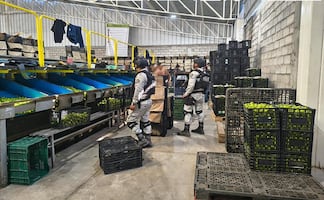Más Información

FGR investiga caja negra del Tren Interoceánico y concluye necropsias; despliega peritos en 13 especialidades

A 50 días del Plan Michoacán, detienen a 278 personas; realizan recorridos a empacadoras e industrias cítricas

Prueba piloto para afiliar a trabajadores de plataformas digitales aún no termina, explica IMSS; acciones continúan, dice

Detienen y vinculan a proceso Alejandro Baruc “N” en Uruapan, Michoacán; podría estar relacionado con el asesinato de Carlos Manzo

Emiten alerta en seis estados por robo de cilindro con gas cloro; advierten por alto nivel de toxicidad
The Mayan Train will run on diesel, which will cause a serious problem because the Mexico's oil industry does not and will not produce enough this kind of fuel by 2023 and even less ultra-low-sulfur diesel to reduce contamination.
According to information from the Energy Ministry , not even with the operation of the Dos Bocas Refinery could Mexico have enough diesel to supply one of the signature projects of the current administration, which means the train would have to run on imported fuel .
In the cost-benefit assessment of the Mayan Train by the National Fund for Tourism Promotion (FONATUR) , it was argued that a diesel train was compared to an electric one and “it was concluded that the project planned on diesel is less expensive than the electric one in terms of Equivalent Annual Cost (CAE) .

Recommended: President López Obrador inaugurates the construction of the Mayan Train
“The CAE of the electric alternative is 6.8% higher than the diesel alternative… in addition, the electric traction alternative would need detailed studies to guarantee its feasibility for the connection of load centers, where there are possible restrictions and works needed to keep the reliability of the National Electric System with the CENACE , which could cause delays.”
However, the assessment does not specify the volume of diesel required by the Mayan Train in 2023.
Nevertheless, the dealer that wins the contract for its operation will be able to choose between purchasing diesel from Pemex or private companies – the latter depend on supply from U.S. refineries .
“In 2023, we will inaugurate the train in the five stretches, Palenque , Campeche , Yucatán , Cancún , and Tulum ; and in 2024, the Tulum-Carrillo Puerto-Escárcega stretches, the one the Army will finish” asserted President Andrés Manuel López Obrador on June 1 at the inauguration of the construction of the Mayan Train .
Recommended: Everything you need to know about the Mayan Train project
Shortage
Mexico does not produce enough diesel to cover internal demand, mainly of cargo and passenger transport.
Pemex
data until the first quarter of 2020 show that the national production of this fuel is of 113.7 thousand daily barrels – only 40% of what is produced by the state oil company is low-sulfur quality – whereas the demand is of 216.6 thousand daily barrels , a deficit of 102.9 daily barrels.
To cover the demand, Pemex and private companies imported 141.9 daily barrels , over twice than was is produced in the country.
In 2019, according to the Hydrocarbons Deputy Ministry of the Energy Ministry , 35% of diesel imports were made by private companies.
65% of external purchases were by Pemex, which brought diesel produced in China , the U.S., and Japan .
The problem goes beyond 2023 because, according to the projections of the 2018-2032 Crude Oil and Fossil Fuels Prospective , even after the Dos Bocas Refinery starts its operations, Mexico will keep importing diesel with annual volumes of 61.6 thousand daily barrels between 2023 and 2032.
Ultra-Low Sulphur Quality
It was expected for Pemex to able to offer ultra-low-sulfur diesel by 2019, but on January 16, 2019, and by the suggestion of Energy Minister Rocío Nahl e, the Energy Regulatory Commission extended the term so that there would be clean diesel starting on 2025 due to the impossibility of producing that fuel to comply with the NOM-016-CRE-2016 standard on Fuel Oil Quality.
Recommended: Mexico defers clean diesel rule for Pemex
mp
Noticias según tus intereses
[Publicidad]
[Publicidad]









